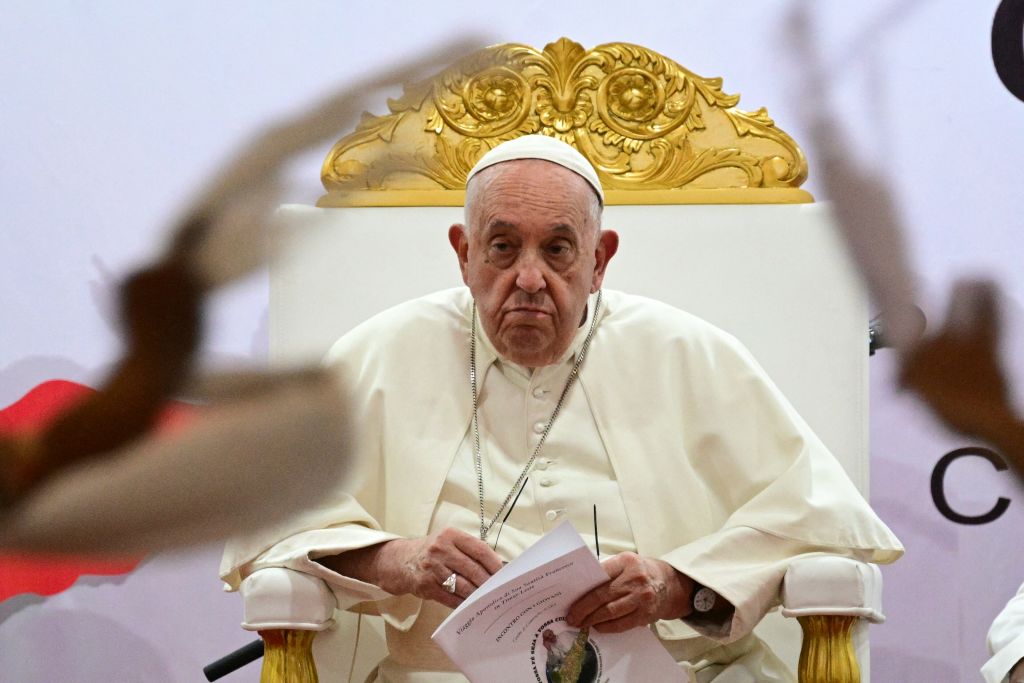The Pontiff is in Singapore, the last stop on what has been generally acknowledged as a successful 12-day, 20,000 mile tour of the Asia-Pacific region.
Pope Francis is ending his tour of the Asia-Pacific, which covered 32,000 kilometres (20,000 miles) and saw him visit Indonesia, Papua New Guinea, East Timor, and Singapore over the past 12 days.
Although confined to a wheelchair for much of the time, the 87-year-old was determined to complete a schedule of over 40 events, which Vatican insiders attributed to his desire to show that he was still up to the job of leading the world’s 1.4 billion Catholics.
With church membership declining in the West, Asia is assuming increased strategic importance in preserving and growing the faith.
Except for Singapore, which is relatively settled, the Pontiff chose to visit nations with a range of internal problems.
Indonesia
Nowhere was that more apparent than at his first stop, when Indonesian police revealed they’d foiled a terror plot, allegedly by ISIS members, arresting seven people after finding bows and arrows, a drone, and propaganda materials from the Islamic terror group.
Indonesia is the largest Muslim country in the world, and most Islamic organisations and leaders responded warmly to the Pope’s presence, which included a visit to the Istiqlal Mosque.
While there, the Pontiff met with grand imam Nasaruddin Umar and representatives from Indonesia’s six officially recognised religions—Islam, Catholicism, Protestantism, Buddhism, Hinduism, and Confucianism, emphasising one of the key themes of his tour, interfaith dialogue.
But while his call for tolerance was widely endorsed, beneath the surface there are still Muslim groups in Indonesia—some small, but a few significant—for whom things are far from friendly.
For instance, the Indonesian Council of Ulema (MUI, Indonesia’s top Muslim clerical body), said the visit would set the momentum for people of different faiths to strengthen their commitment to building peace in the world.
But as recently as 2005, it issued a fatwa (religious edict) declaring secularism, pluralism, and liberalism “deviant” and has yet to withdraw it.
And while minorities within Islam, such as the Shias and Ahmadis, are not harmed in the same way as they were a decade ago, the majority Sunnis continue to shun them.
Papua New Guinea
The next leg, in Papua New Guinea, was very different. From leading a Mass in front of hundreds of thousands in Jakarta, Pope Francis headed inland to a remote PNG village called Vanimo, swapping the Papal jet for a Royal Australian Air Force C-130.

There, he met with the local Catholic community and missionaries from his native Argentina who have been ministering to them, and delivered toys and medical supplies.
Despite the difficulty of travelling to the small village, which has a population of 11,000, an estimated 20,000 Catholics and onlookers turned up to hear him preach.
In a clear reference to the tribal violence over land and other disputes that have long seen people injured and killed, he told villagers to be good to one another.
Doing so, he said, would help to “drive out fear, superstition, and magic from people’s hearts, to put an end to destructive behaviours such as violence, infidelity, exploitation, alcohol, and drug abuse—evils which imprison and take away the happiness of so many of our brothers and sisters.”
There are about 2.5 million Catholics in Papua New Guinea out of a population of approximately 10 million. The Catholics practice the faith alongside their traditional Indigenous beliefs, including animism and sorcery.
East Timor
Then it was on to East Timor, one of only two predominantly Catholic countries in Asia and where an estimated 600,000 people attended his mass—almost half the nation’s 1.3 million population.
Also known as Timor Leste, it is one of the world’s youngest countries and has deep ties to the Catholic Church, which was influential in its often violent fight for independence from Indonesia. Located between northwestern Australia and Indonesia, the country occupies half of the island of Timor.

In 2022, the Vatican confirmed that it had sanctioned Belo two years before, following allegations from two men who said the Bishop raped them when they were teenagers and gave them money to buy their silence.
While he did not refer to any specific case, the Pontiff told the country’s leaders in its capital city, Dili: “Let us not forget the many children and adolescents whose dignity has been violated.”
He then called on people to do “everything possible to prevent every kind of abuse and guarantee a healthy and peaceful childhood for all young people.”
Authorities came under fire for demolishing homes and evicting dozens of people in the area where the mass was held.
Sept. 12 is the Pope’s second and last day in Singapore. He has been formally welcomed to Parliament, met with Prime Minister Lawrence Wong, and called on President Tharman Shanmugaratnam.
Later, he will celebrate mass at the National Stadium, which is expected to be attended by 50,000 people.
According to the Roman Catholic Archdiocese, there are about 395,000 Catholics in Singapore.

